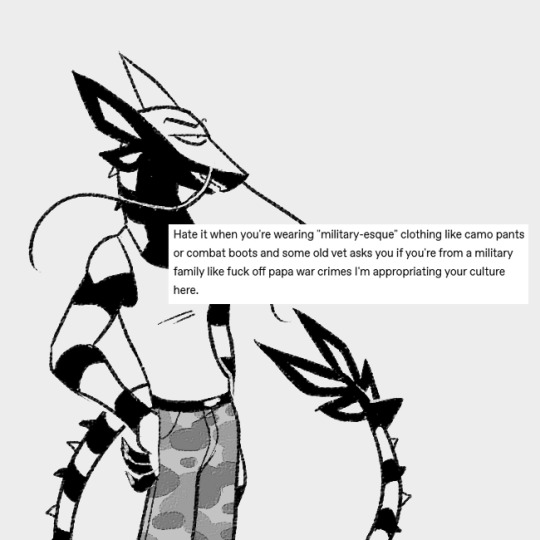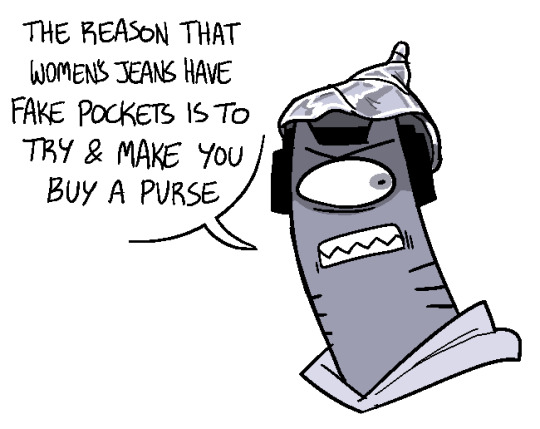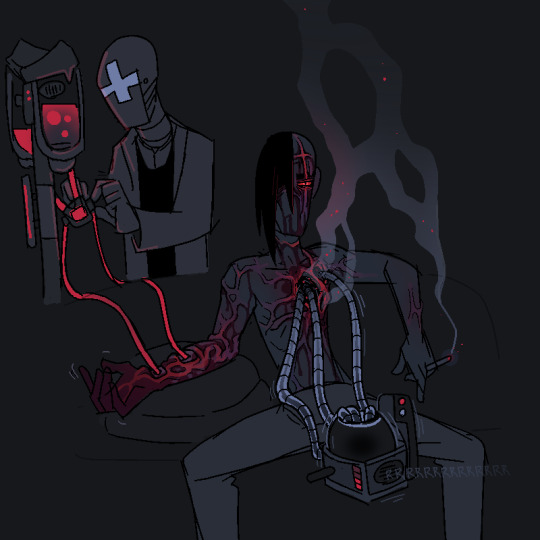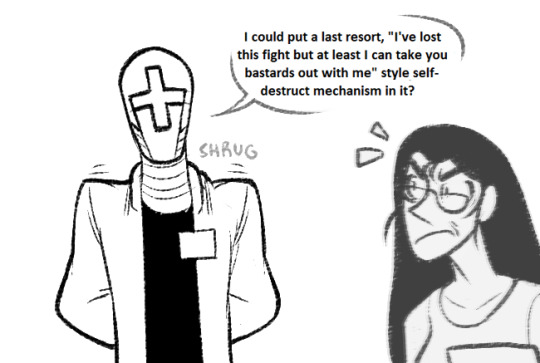#dr zoic
Text


he is basically neutral with a solid moral compass but he is also an inscrutable troll who will pull some bugs bunny trickster god shit for -no- reason if he's bored. he will leak details about a damning government coverup but mostly for the fact it will cause drama. he also has a habit of doing JJBA poses while giving you terrible news.
(he thinks this is fine because no matter how bad it sounds he is still confident he can fix whatever the problem is, and he usually can 99% of the time)
#mog art#robot#dr zoic#cupidiom#its pronounced 'zo-ick' btw like mesozoic like time periods#he is incredibly fucking old#he may not have been a robot at the start of his life but nobody knows his origins for sure#he will change his answer every time he is asked#i may tweak his design in full later this was another bit character with a stand-in design who became just recurring enough#that the stand-in design stuck before i got to giving it more thought#idk a more unique faceplate situation mayhaps? i'll get back to it
96 notes
·
View notes
Photo

Odds are, you've been saying this children's book author's name wrong since you (or your children) were young. No, it doesn't rhyme with "Zeus." Instead, it rhymes with "voice," making the pronunciation "Soice."
Alexander Liang, a friend of Dr. Seuss, wrote a brief poem to remind people of the correct pronunciation:
You’re wrong as the deuce
And you shouldn’t rejoice
If you’re calling him Seuss.
He pronounces it Soice (or Zoice).
16 notes
·
View notes
Text
9m Lexembr
detaxion /ˌde.takˈsjɔn/ synthesis, amalgamation, combination, creation of something complex or coherent by combining simpler things; transmutation, transfiguration, modification, affecting the structure or composition of a substance or work; (chemical) reaction, conversion, process by which substances are changed into others through combination and decomposition
Etymology: borrowed into Boral in the late sixteenth century from Scholastic Latin dētaxiō "chemical reaction", popular variant of dētactiō by analogy with nouns such as connexiō "junction". This dētactiō is a nominalisation of verb dētingō "I affect, cause to undergo a transformation or reaction", from tangō "I touch, arrive at, affect". The alchemical sense is original; extension to other contexts is in evidence by the time of the Long Peace.
Comburnç no's for detaxion con ignifex magn hastous.
/kɔmˈbɪ.rn̩ts noz fɔr ˌde.takˈsjɔn kɔn ˌaj.niˈfɛks mɛjn hasˈtuz/
[kʊmˈbɪːnts noz fɔː ˌde.tɐkˈsjɔn kɔn ˌaj.nɪˈfɛks mɛjn hɐˈstuz]
burn-nmlz neg=be.3s only synthesis with oxygen very fast
Burning is just a very fast reaction with oxygen.
---
excerpt from Albick Medicine in the Workshop Decades, Part V: Alchemick Detaxion, one of the volumes in a series released by the Conster Health Edifice and funded by the anthracite administration's Ministry for Health. This volume was written by Dr Harold Westcamp and published in 1994, with additions by his deixist collaborator Marcathow Cox.
…use copper in their fecundation projects, showing a surprisingly-modern understanding of the unity of zoia [micro-organisms] and edifice life (that is, comprehending that substances noxious to the one were apt to have a similar effect on the other.
But however helpful the counter-zoic properties of copper (as well as the less-effective jast [zinc] and silver), truly safe handiwork could not be achieved without liquid diffruction. Wine and other fermented drinks had been noted as a preventative of infection since the medieval period, and the wider availability of distilled lembick [ethanol] in the sixteenth century allowed Arnoutszen to recommend it in his great treatise.
The advances of the Long Peace led to the discovery of yet more effective solutions. The saltpetre mills (built to provide a source of the gunpowder component in the absence of natural deposits) of Zampanagar and neighbouring Tacday Ancore [1] made use of sea wrack as a raw ingredient. In 1778, according to the reports of the overseer at the Contare mills, a purplish vapour was seen rising from disposal vats in which the waste was treated with vitriol. Named for the colour of the crystalline residue formed as the element accumulated, news of the discovery of tin-sow (literally "indigo element") travelled west over the next decade, and writers in Latin eventually settled on the name janthine, from the…
---
[1] polities in South East Asia, roughly coterminous with southern Vietnam and Cambodia.
#conlang#boral#conlanging#lexember#lexember2021#lexember 2021#boralverse#alternate history#conworld#conworlding#writing
5 notes
·
View notes
Text
1. Seuss
Pen names don't always make things easier. Theodore Geisel's college buddy Alexander Liang made a rhyme to teach you the right way to pronounce Dr. Seuss's name:
"You're wrong as the deuce/And you shouldn't rejoice/
If you're calling him Seuss/He pronounces it Soice" (or Zoice).
1 note
·
View note
Text
random trivia of the day that made me question my childhood
Dr. Seuss is pronounced Zoice.
everyone, tv, movies, people, me have been mispronouncing it. I would say my life feels like a lie, but looking back some stuff makes a little more sense now.
despite this I’m still going to say Suess.
#Dr. Seuss#now I'm wondering how many other names I have been lied to about#is my childhood full of lies o-o
2 notes
·
View notes
Text
Dr Seuss Task 1
Theodore Seuss Giesel or Ted Giesel was born in Springfield, Massachusetts in 1904, but his family originated in Bavaria, Germany and the name Seuss is pronounced Zoice. Initially he wanted to achieve a Ph.D in English literature after graduating at Dartmouth he moved on towards Oxford where he studied literature from 1925-1926.
One day after class his classmate (future wife) told him “You’re crazy to be a professor. What you really want to do is draw”. After finishing the M.A they got engaged and Ted thought about becoming a Scholar but later decided he did want to draw instead, so he left higher education and returned to U.S to become a Cartoonist. He first established himself by drawing for Advertising campaigns, in 1928 Seuss drew a knight which remarks “Darn it all, another dragon, and just after I’d sprayed the whole castle with flit!” Which then he was hired to draw ads for Flit. Another Ad he draw grew a large popularity where the catchphrase was “Quick, Henry, the flit!” and later created ads for Holly Sugar, NBC, Ford, General Electric and many others. The next 30 years of his life was based around advertising for his main source of income.
His first ever published children’s book was “And to think I saw it on Mulberry Street” (1937) and the thirteenth was “The Cat in the Hat” (1957). His contract with Standard Oil (Makers of Flit) disallowed him to taking other types of writing but not writing for children’s books. His Wife, Helen was unable to have children and sometimes his friends would brag about their own children so he included his imaginary daughter Chrysanthenum-Pearl in his Books and would boast about her achievements. The 500 hats of Bartholomew Cubbins (1938) was dedicated to Chrysanthenum-Pearl. Horton Hatches the Egg is based upon an Adoptive Father who looks after Mayzie’s Egg which hatches into an Elephant-bird who Horton parents. He would respond with the question about how he could write such great children’s books without actually being a parent himself with “You make em, I’ll amuse em” which would be taken literally. Later in 1968 he married his second wife, Audrey where Seuss acquired two Step-daughters, but throughout his life he never actually had children of his own. The book “And to think that I saw that on Mulberry Street” was rejected over 20 times by publishers and constant attempts to publish the book right before he decided to scrap the entire idea he ran into a fellow classmate who was Juvenile Editor for Vanguard Press where Seuss signed a contract for “Mulberry Street”.
During the 1940s he started on his fifth book McElligot’s Pool, the book was later postponed for 6 years due to the war and how it influenced Seuss, where he created a new character named Lindberg the Ostrich (based on World Renowned American Pilot and Prominent Isolationist, Charles Lindberg). Throughout the war he believed that it was inevitable the war would happen so he would start his 21 month career as a political cartoonist publishing over 400 Cartoons for New York newspaper PM. His cartoons would mock isolationists like Hitler, Benito Mussolini and Hideki Tojo, they opposed fascism and discriminated to races and religions. Seuss was sensitive to social injustice and considers his own experiences is one of the influences for his creativity.
0 notes
Note
Did it… hurt when Zoe got peeled? Like was it a surgical procedure or just magic?
Surgical procedures, but given the setting there was probably some magic in the mix somewhere. Originally he was just getting wings removed for the purpose of getting the spinal node needed for the mirage wheel implanted, but

#ask x#zoetrope#dr zoic#mog art#doodles#he is half fairy half incubus so he definitely had some features besides the wings at some point#before sanding as much of them off as possible#the tail might be canon but the nose is not i just wanted the extra joke#he doesnt consider the wing thing a loss bc the mirage wheel lets him just float around anyway and with less effort he's lazy
52 notes
·
View notes
Photo










miscelaney-oo
#mog art#cyclops#doodles#nickle#chlorine#rebus#grimstone#demersa#jaren#paisley#zoetrope#body horror cw#smoking cw#veins cw#dr zoic
187 notes
·
View notes
Note
is demersa trans, does the scarring extend to her torso, or is she titless Just Because
The scarring extends to her torso - the incident happened when she was young and seriously ravaged so much underlying tissue that her body just did not/could not develop a breast on that side when puberty hit. The other one did grow in, but she opted to have it surgically removed so both sides could be more even/balanced.
Not that I draw her shirtless much, but unsurprisingly, her top surgery scar is practically invisible compared to the rest

goofy bonus mini doodle flashback under the cut



#mog art#ask x#demersa#bare chest cw#scars cw#dont worry tumblr i censored her scandalous Female Presenting Nipple#all that said if any trans women hc demersa as trans that's awesome and i won't discredit or joss that idea#dr zoic
97 notes
·
View notes
Text
16m Octobr
extract and Borlish translation from textbook Albick Medicine in the Workshop Decades, Part V: Alchemick Detaxion, written by Dr Harold Westcamp and published 1994 by the Conster Health Edifice, funded by the Markland Ministry for Health.
Portant y benoç por y natur contr-zoia a cuivr ant ci issent spandent y laðessem no sera for y retenour stauron.
But the application of copper’s counter-zoic [1] manner with the furthest-reaching consequences can only be the stauron retainer [2].
Nentamen, majour es ig nostr y sgart modern sevrar deull'ig temporane. Y ci nos appariscent com sodal evident dy stauron recaren mout dezein d'annað por hiembr.
Nonetheless it is important to separate our modern point of view from the contemporary. What seem to us like obvious components of the retainer often took dozens of years to innovate.
Parmig, y croy T dy stauron modern smarc noc prell'ascuranç a 1877 dy Majon Sanater de Sant Agrippina—model tostessem contenen annel e helix !
For example, the T-cross of the modern retainer doesn’t arise until the St. Agrippina Medical House 1877 patent—earlier designs included rings and helices!
Y gat theoretic avant l'oc façon a coyenç defassar sta comprendr ig cuivr metal poðe casel sperm occir, tant com zoia.
The theoretical barrier to developing this kind of prevention was recognising that copper metal could kill sperm cases as well as zoia.
Ig degnant y natur contr-zoia a cuivr au stað mis a regest a e posc 1789 (ig inclus y ci ouvr d'alchemist Suxúmawaca bint as-Sáffat), l'oc parceuçon spandr fin a sperm covrir vole noc advenir pre 1824, ny traiscnant dell'Abat Teudesc Dovem.
Although copper’s counter-zoic manner had been documented since 1789 (see the work of alchemist Suxúmawaca bint as-Sáffat), extending this observation to sperm would have to wait until 1824, in the aftermath of the Second German War.
---
[1] anti-microbial
[2] intra-uterine device
#conlang#boral#conlanging#boralverse#conworld#alternate history#cottidian 2020#mondifex 2020#translation
2 notes
·
View notes
Text
8m Aost
taken from textbook Albick Medicine in the Workshop Decades, Part V: Alchemick Detaxion, written by Dr Harold Westcamp and published 1994 by the Conster Health Edifice, funded by the Markland Ministry for Health.
...as in the writing of physician Dr Mickel Cráyenschot, noted for being an early supporter of Deviance Theology and public tovarick in France even as it embraced the Modest Arrangement.
But the application of copper's counter-zoic [anti-microbial] manner with the furthest-reaching consequences can only be the stauron retainer [intra-uterine device]. Nonetheless it is important to separate our modern point of view from the contemporary. What seem to us like obvious components of the retainer often took dozens of years to innovate. For example, the T-cross of the modern retainer doesn't arise until the St. Agrippina Medical House 1877 patent—earlier designs included rings and helices!
The theoretical barrier to developing this kind of prevention was recognising that copper metal could kill sperm cases as well as zoia. Although copper's counter-zoic manner had been documented since 1789 (see the work of alchemist Suxúmawaca bint as-Sáffat), extending this observation to sperm would have to wait until 1824, in the aftermath of the Second German War. Former mozardisto and farm theorist Ricardo Ivarrachezurí wrote in that year that "the seed of the bull, the ram and the stallion alike are made impotent in storing them for some hours in a syringe of copper; in this we can suppose we see the same mechanism that dispels the cholera from water in a copper cauldron".
In fact, Ivarrachezurí published these findings as a warning to other farmers and horse breeders not to use copper in their fecundation projects...
#conlang#boral#conlanging#boralverse#conworld#alternate history#mondifex 2020#cottidian 2020#writing
2 notes
·
View notes